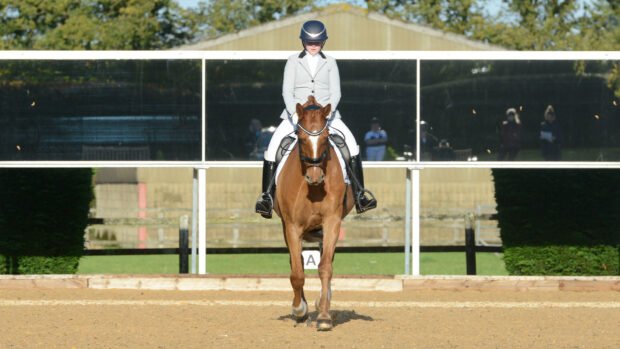US dressage rider, trainer and author Jane Savoie, who passed away in December 2020, shared some useful exercises to help horses that tend to change late behind in a flying change
When learning this movement, some horses find it difficult to change both front and hind legs simultaneously during a single stride, resulting in a flying change that is “late behind”, meaning the front legs change first and the hind legs switch a stride or more later. While this isn’t a problem for jumpers, in dressage this error will be heavily penalised.
Exercises to help flying changes that are late behind
1. Counter-flexion
Ride plenty of counter canter, but counter-flex your horse at the poll. Alternate between true flexion and counter-flexion until he feels soft.
2. Counter supple
Supple your horse away from the lead you are on. For example, if you are on the right lead in canter, take his neck 7 inches to the left three times. When your horse can do this easily without stiffening or swinging his hindquarters out, he is ready to start flying changes.
3. Half Pass
Start a canter half pass to the right. Go sideways for a few strides, and then continue to move right, but bend your horse’s neck to the left. Once your horse feels soft on his left side, straighten his neck completely. Ride straight forward, and immediately ask for the change before you lose the softness on the left side of his body.
4. Serpentine
Canter a three loop serpentine. As you approach the center line to start the second loop, slide your new inside leg forward on the girth. Leg yield with a bend for a stride or two toward your new outside rein. If your horse feels stiff in his rib cage and leans on your new inside leg, don’t do the second loop. Instead, stay on the first loop. As you approach the center line again, try the leg yield with a bend once more. Keep doing this part of the exercise until your horse bends softly around your new inside leg. Once this happens, ask for the flying change, and arc onto the second loop of the serpentine. Do the same thing as you approach the center line for the third loop.
5. Haunches-in (a working pirouette)
Ride haunches-in in the canter on a small circle. When you feel your horse lower his hindquarters, leave the circle. Ride straight forward on any line, and immediately ask for the flying change. Do the circle somewhere in the middle of the ring so you can leave the circle at any moment without running into the wall or fence.
6. Engage the inside hind leg
Give three preparatory half halts when the inside hind leg is on the ground. (That’s the moment when your seat is deepest in the saddle, and your horse’s mane flips up.) Take and give with your seat, legs, and inside hand in sync with the rhythm of the canter. Do it during the second beat of the canter so you can influence the inside hind leg when it’s on the ground. After the three quick preparatory half halts, ask for the flying change.
To help you get into the rhythm of giving the half halts and the actual aid for the flying change, count out loud, “One, two, three, change”. For example, if you’re changing from right lead to left lead, give the half halts on the right rein. On the fourth stride, when you say the word, “Change”, close your right hand in a fist again, and also bring your right leg back to ask for the flying change.
7. Use the whip to engage the inside hind leg
If preparatory half halts don’t engage your horse enough, use a touch with the whip in a similar way. Say “Now, now, now” each time you tap your horse with the whip on his inside hind leg. Tap as firmly as you need to get that leg active and jumping. It should feel like your horse’s hind legs are begging to switch leads. When you feel that eagerness, give the aid for the flying change.
8. Haunches-out (Renvers)
Ride to the left in right lead counter canter one-meter away from the wall. Bend your horse around your right leg, and ask for haunches-out. (His forehand will be one meter to the inside of the wall, and his hindquarters will be in the track.) Once this feels easy, keep all four legs in the same position, but straighten his neck. (Because he’s on three tracks in haunches-out, his neck will actually be at a diagonal to the wall when you straighten it.) Close your left leg and push his left hind leg toward your right hand. Go back and forth from haunches-out with bend to straightening his neck. When your horse feels like he’s stepping from your left leg into your right hand, ask for the flying change.



